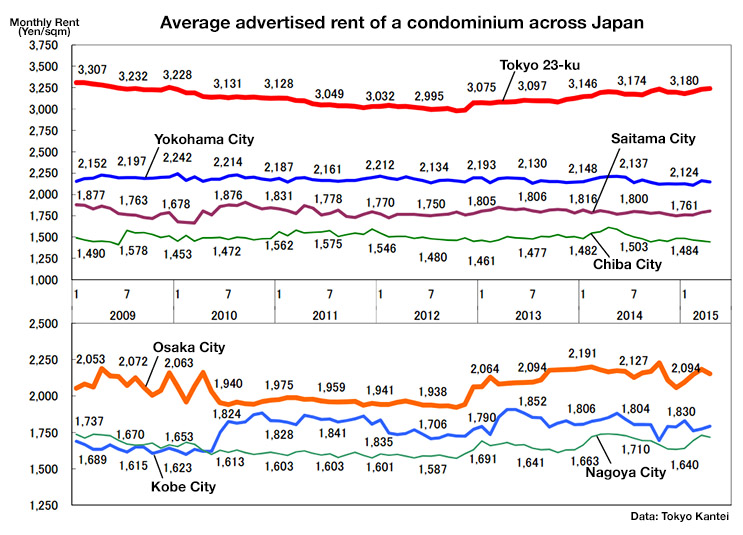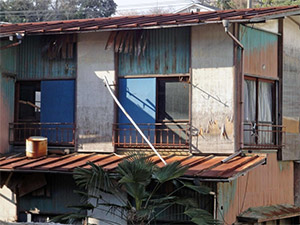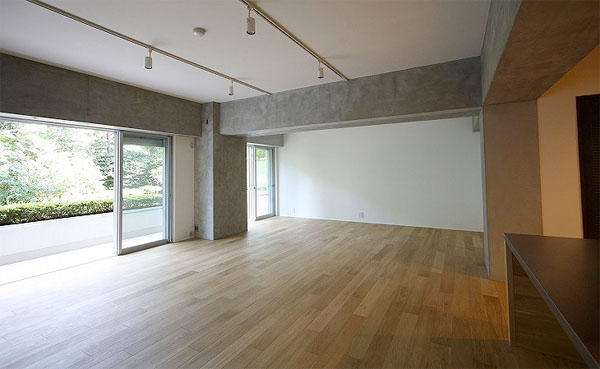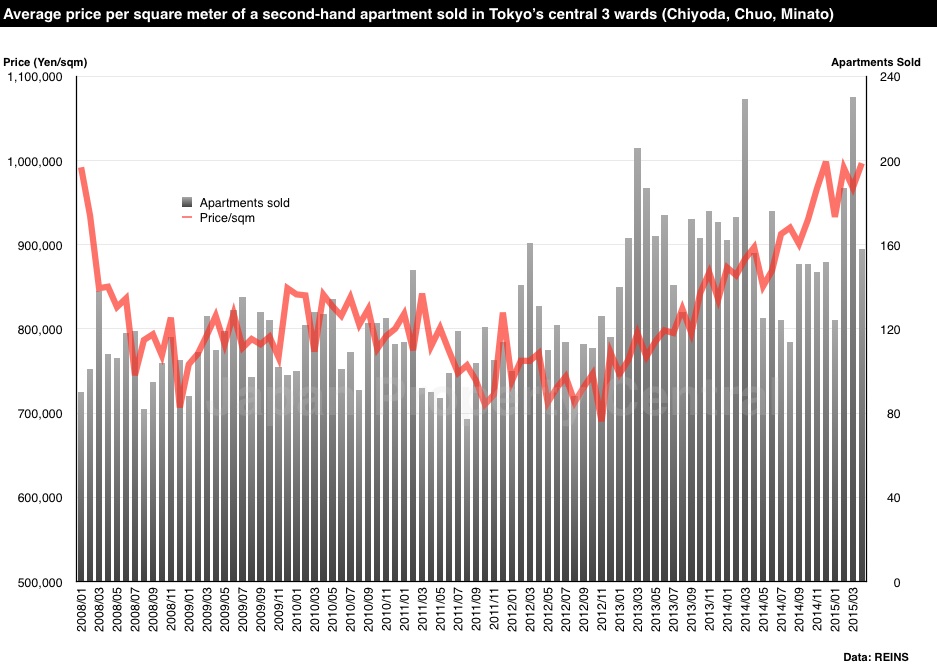Office vacancy rates see slight increase in April
According to Miki Shoji’s Office Report, the office vacancy rate in Tokyo’s five central business districts (Chiyoda, Chuo, Minato, Shinjuku and Shibuya) was 5.34% in April, up 0.04 points from the previous month but down 1.30 points from last year. This is the first time in 21 months that the rate has increased from the previous month. Two large-scale office buildings were completed last month, which was considered to be a contributing cause to the increase in the vacancy rate.
The vacancy rate in brand new buildings was 33.21%, up 2.85 points from the previous month and up 13.76 points from last year.
The Tokyo Nihonbashi Tower was completed in Chuo-ku in April. The 35-storey, 180m tall tower has a total floor area of 133,334 sqm (1.4 million sq ft).Read more
April 2015 rental data - Tokyo Kantei

According to Tokyo Kantei, the average monthly rent of a condominium in greater Tokyo was 2,601 Yen/sqm in April, down 0.5% from the previous month and down 1.4% from last year. The average apartment size was 59.68 sqm and the average building age was 18.8 years.
In the Tokyo metropolitan area, the average rent was 3,120 Yen/sqm, up 0.5% from the previous month and up 1.1% from last year. The average apartment size was 56.68 sqm and the average building age was 17.1 years.
In Tokyo’s 23 wards, the average rent increased for the third consecutive month, and has exceeded the previous peak last seen in October 2014. Yokohama and Chiba City have seen a slight drop in rent from the previous month, with Chiba showing a downwards trend from the beginning of the year.Read more
Secondhand apartment transactions up for first time in 13 months
According to REINS, 2,808 second-hand apartments were sold across greater Tokyo in April, down 24.7% from the previous month but up 0.8% from last year. This is the first time in 13 months to see an increase in transactions from the year before. February and March are typically the busiest months of the year for sales, so it is not surprising to see transactions down from March.
The average apartment sale price was 28,280,000 Yen, down 3.2% from the previous month but up 5.2% from last year. The average price per square meter was 445,500 Yen, down 1.7% from the previous month but up 5.1% from last year. The average building age was 20.11 years.
1,377 apartments were sold in the Tokyo metropolitan area, down 25.3% from March but up 1.0% from April 2014. This is also the first time in 13 months to see a year-on-year increase in transactions. The average sale price was 34,900,000 Yen, down 1.9% from the previous month but up 3.6% from last year. The average price per square meter was 597,400 Yen, down 1.9% from the previous month but up 3.6% from last year. The average building age was 18.95 years.
In central Tokyo’s 3 wards (Chiyoda, Chuo and Minato), 158 apartments were sold, down 31.3% from the previous month but up 1.3% from last year. The average sale price was 53,600,000 Yen, down 1.3% from the previous month but up 11.3% from last year. The average price per square meter was 996,800 Yen, up 3.0% from the previous month and up 11.1% from last year. The average building age was 16.24 years.Read more
68% of Japan’s empty homes are in old buildings
 According to a survey by the Ministry of Land, Infrastructure, Transport and Tourism (MLIT), approximately two-thirds (68.9%) of Japan’s vacant homes are in buildings built before 1980. Older properties that have been left to rot, particularly those built to the old earthquake construction codes (called ‘kyu-taishin’), can be at risk of collapse and are a danger to neighbours.
According to a survey by the Ministry of Land, Infrastructure, Transport and Tourism (MLIT), approximately two-thirds (68.9%) of Japan’s vacant homes are in buildings built before 1980. Older properties that have been left to rot, particularly those built to the old earthquake construction codes (called ‘kyu-taishin’), can be at risk of collapse and are a danger to neighbours.
44.5% of the vacant homes were built before 1970, and 24.4% were built between 1971 ~ 1980. In 1981, the major change to Japan’s earthquake-resistant construction codes was introduced.
Hidetaka Yoneyama, a senior researcher at the Fujitsu Research Institute, said that the low market value of kyu-taishin properties means that there are many cases where they are simply abandoned.Read more
99-year old residence in Kamakura opened to public for first time

A historic residence in Kamakura that was once the holiday home of former Prime Ministers Fumimaro Konoe (1891 - 1945) and Osachi Yamaguchi (1870 - 1931) has been repaired and converted into a French restaurant and wedding function centre. This historic, privately-held home had been closed to the public until now.
The Koga Residence was built in 1916 as a villa for Seijiro Sho (1862 - 1926), the managing director of Mitsubishi. In 1937 it was purchased by Mr. Koga, a manager of Nippon Tochi-Tatemono, and has been in the Koga family ever since.Read more
Renovated apartments offer cheaper alternative to new

There is a common belief that Japanese only like new things - new cars, new appliances and new homes. However, with the price of new apartments rising and incomes falling, buyers have been turning their attention to older properties on the resale market.
Second-hand apartments can be about 20% lower than the price of a brand new one, although in prime locations in central Tokyo the difference in price is almost zero. As you move to the outer suburbs, eg. 40 minutes by train from Tokyo or Osaka, you can find older properties for about half the price of new ones in the same area. Travel even further and you may find secondhand apartments in 10-year old buildings selling for just 30 ~ 40% of the price of a new apartment.
An apartment’s interior can be upgraded to almost the exact finish as a brand new apartment, although consumers do need to be wary of factors such as the building age and possible issues with piping.Read more
Earthquake insurance premiums could rise by 30%
Earthquake insurance premiums on residential real estate in Japan could rise by as much as 30% to reflect updated earthquake risk predictions.
Up until now, the highest premium hike was in July 2014 when premiums were raised by 15.5% in response to the 2011 Tohoku disaster. To lessen the immediate burden on consumers, the Financial Services Agency, which is in charge of approving insurance premiums, is considering applying the increase in stages over several years. The higher premiums could go into effect as early as next year.Read more

